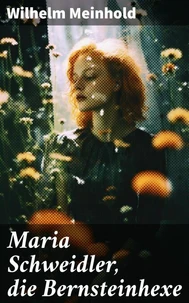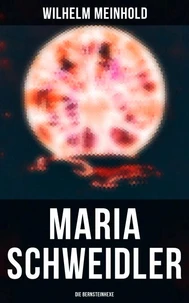The Amber Witch
Par :Formats :
Disponible dans votre compte client Decitre ou Furet du Nord dès validation de votre commande. Le format ePub est :
- Compatible avec une lecture sur My Vivlio (smartphone, tablette, ordinateur)
- Compatible avec une lecture sur liseuses Vivlio
- Pour les liseuses autres que Vivlio, vous devez utiliser le logiciel Adobe Digital Edition. Non compatible avec la lecture sur les liseuses Kindle, Remarkable et Sony
 , qui est-ce ?
, qui est-ce ?Notre partenaire de plateforme de lecture numérique où vous retrouverez l'ensemble de vos ebooks gratuitement
Pour en savoir plus sur nos ebooks, consultez notre aide en ligne ici
- Nombre de pages114
- FormatePub
- ISBN978-3-96189-606-6
- EAN9783961896066
- Date de parution02/05/2017
- Protection num.pas de protection
- Taille350 Ko
- Infos supplémentairesepub
- ÉditeurChiemsee Verlag
Résumé
The Amber Witch is a German novel published by Wilhelm Meinhold (1797-1851) in 1838. Its German title is Maria Schweidler, die Bernsteinhexe. The novel was originally published as a literary hoax which purported to be an actual 17th-century chronicle. Meinhold later admitted to the hoax but had some difficulty in proving that he was its author. In 1844, it was published in Britain as The Amber Witch in two English translations: one by E.
A. Friedlander and another, more enduring, translation by Lucie, Lady Duff-Gordon. Lady Duff Gordon's translation was very popular with the Victorians and went through numerous editions, including a luxurious one in 1895 illustrated by Philip Burne-Jones. The novel was a favourite of Oscar Wilde's when he was a boy, and in 1861 it was made into an opera, The Amber Witch, composed by William Vincent Wallace.
Wallace's opera has faded into obscurity, but the novel on which it was based has continued to be republished, both on its own and in anthologies. The story is set during the Thirty Years' War. The purported author, Reverend Abraham Schweidler, almost loses his only child, Maria, to a plot by a rejected suitor, Sheriff Appelmann, who has accused Maria of practicing witchcraft. In this he was aided by an evil and jealous woman of the neighborhood.
After a trial and under threat of the most dire torture, Maria, wholly innocent of the crime, confesses. While on her way to the stake, she is rescued by a courageous young nobleman who loves her and who exposes the evil plot against her.
A. Friedlander and another, more enduring, translation by Lucie, Lady Duff-Gordon. Lady Duff Gordon's translation was very popular with the Victorians and went through numerous editions, including a luxurious one in 1895 illustrated by Philip Burne-Jones. The novel was a favourite of Oscar Wilde's when he was a boy, and in 1861 it was made into an opera, The Amber Witch, composed by William Vincent Wallace.
Wallace's opera has faded into obscurity, but the novel on which it was based has continued to be republished, both on its own and in anthologies. The story is set during the Thirty Years' War. The purported author, Reverend Abraham Schweidler, almost loses his only child, Maria, to a plot by a rejected suitor, Sheriff Appelmann, who has accused Maria of practicing witchcraft. In this he was aided by an evil and jealous woman of the neighborhood.
After a trial and under threat of the most dire torture, Maria, wholly innocent of the crime, confesses. While on her way to the stake, she is rescued by a courageous young nobleman who loves her and who exposes the evil plot against her.
The Amber Witch is a German novel published by Wilhelm Meinhold (1797-1851) in 1838. Its German title is Maria Schweidler, die Bernsteinhexe. The novel was originally published as a literary hoax which purported to be an actual 17th-century chronicle. Meinhold later admitted to the hoax but had some difficulty in proving that he was its author. In 1844, it was published in Britain as The Amber Witch in two English translations: one by E.
A. Friedlander and another, more enduring, translation by Lucie, Lady Duff-Gordon. Lady Duff Gordon's translation was very popular with the Victorians and went through numerous editions, including a luxurious one in 1895 illustrated by Philip Burne-Jones. The novel was a favourite of Oscar Wilde's when he was a boy, and in 1861 it was made into an opera, The Amber Witch, composed by William Vincent Wallace.
Wallace's opera has faded into obscurity, but the novel on which it was based has continued to be republished, both on its own and in anthologies. The story is set during the Thirty Years' War. The purported author, Reverend Abraham Schweidler, almost loses his only child, Maria, to a plot by a rejected suitor, Sheriff Appelmann, who has accused Maria of practicing witchcraft. In this he was aided by an evil and jealous woman of the neighborhood.
After a trial and under threat of the most dire torture, Maria, wholly innocent of the crime, confesses. While on her way to the stake, she is rescued by a courageous young nobleman who loves her and who exposes the evil plot against her.
A. Friedlander and another, more enduring, translation by Lucie, Lady Duff-Gordon. Lady Duff Gordon's translation was very popular with the Victorians and went through numerous editions, including a luxurious one in 1895 illustrated by Philip Burne-Jones. The novel was a favourite of Oscar Wilde's when he was a boy, and in 1861 it was made into an opera, The Amber Witch, composed by William Vincent Wallace.
Wallace's opera has faded into obscurity, but the novel on which it was based has continued to be republished, both on its own and in anthologies. The story is set during the Thirty Years' War. The purported author, Reverend Abraham Schweidler, almost loses his only child, Maria, to a plot by a rejected suitor, Sheriff Appelmann, who has accused Maria of practicing witchcraft. In this he was aided by an evil and jealous woman of the neighborhood.
After a trial and under threat of the most dire torture, Maria, wholly innocent of the crime, confesses. While on her way to the stake, she is rescued by a courageous young nobleman who loves her and who exposes the evil plot against her.




